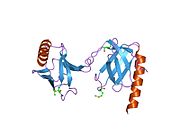- DOK5
-
Docking protein 5 
PDB rendering based on 1j0w.Available structures PDB 1j0w Identifiers Symbols DOK5; C20orf180; MGC16926 External IDs OMIM: 608334 MGI: 1924079 HomoloGene: 10195 GeneCards: DOK5 Gene Gene Ontology Molecular function • receptor signaling protein activity
• insulin receptor bindingBiological process • MAPKKK cascade
• transmembrane receptor protein tyrosine kinase signaling pathway
• nervous system developmentSources: Amigo / QuickGO RNA expression pattern 
More reference expression data Orthologs Species Human Mouse Entrez 55816 76829 Ensembl ENSG00000101134 ENSMUSG00000027560 UniProt Q9P104 Q6NXY7 RefSeq (mRNA) NM_018431 NM_029761 RefSeq (protein) NP_060901 NP_084037 Location (UCSC) Chr 20:
53.09 – 53.27 MbChr 2:
170.56 – 170.71 MbPubMed search [1] [2] Docking protein 5 is a protein that in humans is encoded by the DOK5 gene.[1][2]
The protein encoded by this gene is a member of the DOK family of membrane proteins, which are adapter proteins involved in signal transduction. The encoded protein interacts with phosphorylated receptor tyrosine kinases to mediate neurite outgrowth and activation of the MAP kinase pathway. In contrast to other DOK family proteins, this protein does not interact with RASGAP.[2]
Interactions
DOK5 has been shown to interact with RET proto-oncogene.[3][1]
References
- ^ a b Grimm J, Sachs M, Britsch S, Di Cesare S, Schwarz-Romond T, Alitalo K, Birchmeier W (Jul 2001). "Novel p62dok family members, dok-4 and dok-5, are substrates of the c-Ret receptor tyrosine kinase and mediate neuronal differentiation". J Cell Biol 154 (2): 345–54. doi:10.1083/jcb.200102032. PMC 2150770. PMID 11470823. http://www.pubmedcentral.nih.gov/articlerender.fcgi?tool=pmcentrez&artid=2150770.
- ^ a b "Entrez Gene: DOK5 docking protein 5". http://www.ncbi.nlm.nih.gov/sites/entrez?Db=gene&Cmd=ShowDetailView&TermToSearch=55816.
- ^ Crowder, Robert J; Enomoto Hideki, Yang Mao, Johnson Eugene M, Milbrandt Jeffrey (Oct. 2004). "Dok-6, a Novel p62 Dok family member, promotes Ret-mediated neurite outgrowth". J. Biol. Chem. (United States) 279 (40): 42072–81. doi:10.1074/jbc.M403726200. ISSN 0021-9258. PMID 15286081.
Further reading
- Deloukas P, Matthews LH, Ashurst J, et al. (2002). "The DNA sequence and comparative analysis of human chromosome 20". Nature 414 (6866): 865–71. doi:10.1038/414865a. PMID 11780052.
- Shi N, Zhou W, Tang K, et al. (2003). "Expression, crystallization and preliminary X-ray studies of the recombinant PTB domain of human dok-5 protein". Acta Crystallogr. D Biol. Crystallogr. 58 (Pt 12): 2170–2. doi:10.1107/S090744490201644X. PMID 12454490.
- Strausberg RL, Feingold EA, Grouse LH, et al. (2003). "Generation and initial analysis of more than 15,000 full-length human and mouse cDNA sequences". Proc. Natl. Acad. Sci. U.S.A. 99 (26): 16899–903. doi:10.1073/pnas.242603899. PMC 139241. PMID 12477932. http://www.pubmedcentral.nih.gov/articlerender.fcgi?tool=pmcentrez&artid=139241.
- Favre C, Gérard A, Clauzier E, et al. (2003). "DOK4 and DOK5: new Dok-related genes expressed in human T cells". Genes Immun. 4 (1): 40–5. doi:10.1038/sj.gene.6363891. PMID 12595900.
- Cai D, Dhe-Paganon S, Melendez PA, et al. (2003). "Two new substrates in insulin signaling, IRS5/DOK4 and IRS6/DOK5". J. Biol. Chem. 278 (28): 25323–30. doi:10.1074/jbc.M212430200. PMID 12730241.
- Crowder RJ, Enomoto H, Yang M, et al. (2004). "Dok-6, a Novel p62 Dok family member, promotes Ret-mediated neurite outgrowth". J. Biol. Chem. 279 (40): 42072–81. doi:10.1074/jbc.M403726200. PMID 15286081.
- Gerhard DS, Wagner L, Feingold EA, et al. (2004). "The Status, Quality, and Expansion of the NIH Full-Length cDNA Project: The Mammalian Gene Collection (MGC)". Genome Res. 14 (10B): 2121–7. doi:10.1101/gr.2596504. PMC 528928. PMID 15489334. http://www.pubmedcentral.nih.gov/articlerender.fcgi?tool=pmcentrez&artid=528928.
- Rual JF, Venkatesan K, Hao T, et al. (2005). "Towards a proteome-scale map of the human protein-protein interaction network". Nature 437 (7062): 1173–8. doi:10.1038/nature04209. PMID 16189514.
- Shi L, Yue J, You Y, et al. (2007). "Dok5 is substrate of TrkB and TrkC receptors and involved in neurotrophin induced MAPK activation". Cell. Signal. 18 (11): 1995–2003. doi:10.1016/j.cellsig.2006.03.007. PMID 16647839.
PDB gallery Categories:- Human proteins
- Chromosome 20 gene stubs
Wikimedia Foundation. 2010.

